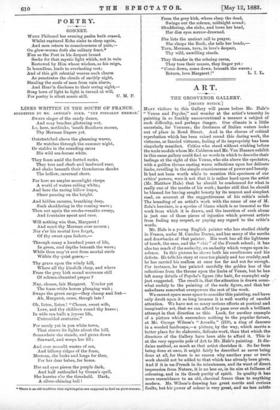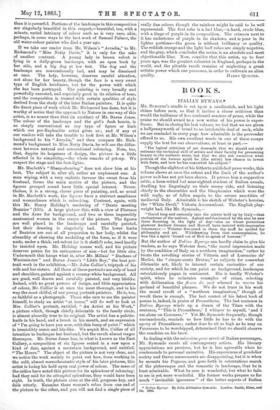ART.
MANY visitors to this Gallery will pause before Mr. Hale's' "Venus and Psyche," and wonder at the artist's temerity in painting in so frankly unconventional a manner a subject of such difficulty, and perhaps danger. Our climate is a little uncertain, for Venuses ; the freshness of Italian waters looks out of place in Bond Street. And in the chorus of critical reprobation which has been raised round this daring work, the virtuous, or fancied virtuous, feeling of its impropriety has been singularly manifest. Critics who stood without winking before the nude models whom Mr. Calderon and Mr. Van Haanen exhibit in this same gallery could find no words in which to describe their feelings at the sight of this Venus, who sits above the spectator,. with a golden throne casting warm reflections upon her delicate limbs, revelling in the simple consciousness of power and beauty. It had not been worth while to mention this specimen of our critics' powers, were it not that it is rather hard upon the artist. (Mr. Matthew Hale) that he should be condemned for what is really one of the merits of his work ; harder still that he should be blamed for having sought beauty by its nearest and simplest. road, on account of the suggestiveness of his critic's mind- The branding of an artist's work with the name of one of M. Zola's heroines, is a socies of blame which is as immoral as the work from which it is drawn, and the insertion of such abase- is just one of those pieces of injustice which prevent artists from feeling any respect, or paying any regard to the critic's words.
Mr. Hale is a young English painter who has studied chiefly in France, under M. Carolas Duran, and has many of the merits and drawbacks of that painter. His work has all the lightness of touch, the ease, and the " chic " of the French school ; it has- also too much of the audacity, an audacity which verges upon in- solence. In this picture he shows both his excellencies and his defects. He tells his story at once too plainly and too crudely, and he has carried his realism at once too far and not far enough._ For instance, he has painted carefully the golden hue of the reflections from the throne upon the limbs of Venn's, but he has. left many details of Psyche's figure (the hair, for example) only just suggested. The result is, that the attention is drawn some- what unduly to the painting of the nude figure, and that her nakedness somewhat overpowers the rest of the work.
We cannot spare more space to consider this painting, and have only dwelt upon it so long because it is well worthy of careful attention. We have not so many serious efforts at poetical and imaginative art, that we can afford to pass over such a brilliant attempt in that direction as this. Look, for another example of a picture which surrenders nothing to the popular favour, at Mr. George Wilson's " Arcadia " (219), a ring of dancers in a wooded landscape,—a picture, by the way, which merits a- better place for its elaborate, delicate work, than that which the directors of the Gallery have been able to afford it This is at the very opposite pole of Art to Mr. Hale's painting. It dis- dains method, as much as that artist cherishes it. So far from being done at once, it might fairly be described as never being done at all, for there is no reason why another year or two's work should not be added to that which has already been given. And if it is un-French in its minuteness, and its want of direct. impression from Nature, it is no less so, in its aim at fullness of colouring, and in its Greek parity of spirit. In quality it has more resemblance to an old, classical fresco than to anything modern. Mr. Wilson's drawing has great merits and curious faults, but his power of colour is very great, and no less subtle
than it is powerful Portions of the landscape in this composition are singularly beautiful in this respect,—beautiful, too, with a minute, varied intricacy of colour such as is very rare, akin, perhaps, in some ways to the best work of Samuel Palmer, the old water-colour painter who died a year ago.
If we take our reader from Mr. Wilson's "Arcadia," to Mr. Richmond's "Miss Netty Davis," it is only for the sake of another contrast. A young lady in brown velvet is dying in a dully-green landscape, with an open book by her side, and a big dog at her feet. The dog and the landscape are conventionally bad, and may be dismissed at once. The lady, however, deserves careful attention, not alone for her beauty, though the face is a very sweet -type of English loveliness, but for the power with which she has been portrayed. The painting is very broadly and powerfully executed, and especially good in its relation of tone, and the composition is treated with certain qualities of style derived from the study of the later Italian painters. It is quite the finest piece of work which Mr. Richmond has done, but it is worthy of notice that the approach to Nature in one way of this artist, is no nearer than that (in another) of Mr. Burne Jones. 'The colour of the landscape and the girl's flesh herein, is as simply conventional as any type of figure or limb which our pre-Raphaelite artist gives us ; and if any of -our readers will take the trouble to look first at Mr. Wilson's background to his "Arcadia," and then compare Mr. Rich- mond's background to Miss Netty Davis, he will see the differ- -ence between natural and conventional colouring. Note, too, that, despite its largeness of design, the picture is a little -affected in its simplicity,—the whole smacks of get-up. We suspect the stage and the foot-lights.
Mr. Macbeth's " Sheep-shearing " does not show him at his best. The subject is, after all, rather an unpleasant one. A man wiping, with a very realistic fervour the sweat from his forehead, forms the main motive of the picture, and the figures grouped round have little special interest. Never- theless, it is a strong, clever piece of painting, and, as usual in Mr. Macbeth's work, the figures have a stalwart manliness -and womanliness which is refreshing. Contrast, again, with -this Mr. Henry Holiday's rendering of "Dante meeting Beatrice" (165). A large picture this, with a view of Florence and the Arno for background, and two or three impossibly anatomical women in the centre of the picture. The figures are well placed in the landscape and carefully painted, but their drawing is singularly bad. The lower limbs -of Beatrice are out of all proportion to her body, whilst the absurdity of showing the modelling of the form, as if it were nude, under a thick, red-velvet (or is it cloth?) robe, need hardly be insisted upon. Mr. Holiday means well, and his picture -deserves praise for its seriousness of aim—but for little else. Underneath this hangs what is, after Mr. Millais' "Duchess of Westminster" and Burne Jones's "Little Boy," the best por- trait work in the exhibition,—Mr. John Collier's triptych of his wife and her sisters. All three of these portraits are only of head -and shoulders, painted against a creamy-white background. All -are good, well drawn and carefully painted, and very lifelike. Indeed, with no great powers of design, and little appreciation -of colour, Mr. Collier is at once the most thorough, and in his way the most skilful, of our young portrait-painters. He is, too, as faithful as a photograph. Those who care to see the painter himself, to study an artist "at home," will do well to look at Mrs. Collier's portrait, entitled, " An Artist at his Work," a picture which, though chiefly delectable to the family circle, -is almost absurdly true to its original. The artist has a palette- knife in his hand, and a brush in his month, and an expression of "I'm going to have you now, with this lump of paint !" which -is irresistibly comic and life-like. We acquit Mrs. Collier of all intention to burlesque her husband, but the result almost verges thereupon. Mr. Burne Jones has, in what is known as the East Gallery, a composition of six figures seated in a row upon a kind of dais, against a mountain background, and entitled, " The Hours." The object of the picture is not very clear, and we notice the work mainly to point out how, from working in the cold, almost monochromatic style of his later pictures, this artist is losing his hold upon real power of colour. The mass of the critics have noted this picture for its splendour of colouring; had they said for its attempted splendour, they would have been right. In truth, the picture aims at the old, gorgeous key, and fails utterly. Examine these women's robes from one end of the picture to the other, and you will not find a single piece of
really fine colour, though the rainbow might be said to be well represented. The first robe is a bad blue,—a hard, crude blue, with a tinge of purple in its composition. The crimson next to it has undertones of purple in its shadows, and is poor in its lighter portions—the green is without brilliancy or quality. The reddish-orange and the light buff robes are simply negative, and the grey, which concludes the series, is an absolute and most objectionable lilac. Now, consider that this artist, up to four years ago, was the greatest colourist in England, perhaps in the world, and the pitiable result remains of neglecting a great artistic power which one possesses, in order to cultivate an alien



































 Previous page
Previous page